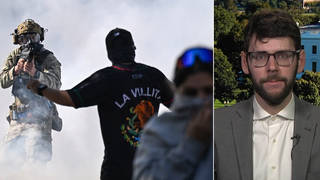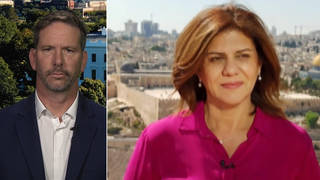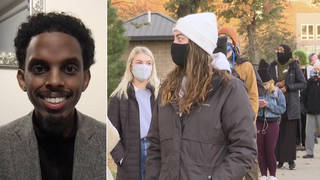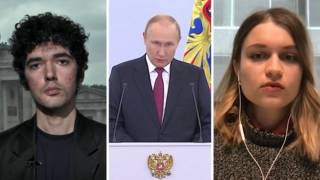
After multiple failed peace talks between Russia and Ukraine, Russia has promised a ceasefire and several so-called humanitarian corridors to allow Ukrainians to flee to predetermined countries, though similar agreements have fallen apart amid continued Russian shelling of civilian areas. We speak to Anatol Lieven from the Quincy Institute for Responsible Statecraft about what a Ukraine-Russia peace deal could look like and what is at stake in a prolonged war. “The world community as a whole is very, very anxious for this war to end,” says Lieven.
Transcript
AMY GOODMAN: This is Democracy Now!, democracynow.org, The War and Peace Report. I’m Amy Goodman.
Russia’s invasion of Ukraine has entered its 12th day. The United Nations says over 1.5 million Ukrainians have fled the country in what the U.N. is calling the fastest-growing refugee crisis since World War II. The U.N. has confirmed 364 Ukrainian civilian deaths, but the actual number is believed to be far higher, as Russia intensifies its attacks. Ukrainian President Volodymyr Zelensky warned Sunday Russia is preparing to attack the key southwestern port city of Odessa, a city of 1 million. The city of Mariupol, which is also in the south, is under siege by Russian forces, and attempts to evacuate trapped civilians repeatedly failed over the weekend. This is Mariupol’s mayor.
MAYOR VADYM BOICHENKO: [translated] During the first days of war, we counted the victims in tens. Today we count them in hundreds, and in two days’ time we will likely count them in thousands. They will not even give us an opportunity to count the wounded and the killed, because the shelling has not stopped for the past six days. … They’ve been working methodically to make sure the city is blockaded, working methodically to create a humanitarian crisis here, so that people are left without food, water, light, heating, means of communication. …
When they told us about evacuations, I felt happy that there is a possibility to save the lives of Mariupol residents. I had hope. … They lied to us. They told us there will be a ceasefire window during daylight, from 0900 to 1800, and they asked us to get ready. We got ready. We organized buses. But despite the fact that they know all the issues the city is facing, the Russian army shelled the convoy of our buses. They destroyed half of them. They did not give us any opportunity to dispatch the buses to evacuation points. Half of the buses were not damaged. We wanted to dispatch them to evacuation points. We asked people to head toward those points. And at this moment the shelling started again.
AMY GOODMAN: That was Vadym Boichenko, the mayor of Mariupol.
Delegates from Ukraine and Russia are holding talks for a third time today, but over the weekend Russia threatened to expand the war. Russian President Vladimir Putin said Western sanctions on Russia are akin to a declaration of war. Russia has also warned other countries against allowing Ukrainian military aircraft to use their airfields. The United States and its allies are continuing to reject calls by Ukraine to set up a no-fly zone, but Western states are increasing support for Ukraine in other ways. The New York Times reports the U.S. and NATO have recently sent more than 17,000 anti-tank missiles to Ukraine. On Sunday, Secretary of State Antony Blinken visited Moldova, where he discussed the possibility of Poland giving fighter jets to Ukraine.
SECRETARY OF STATE ANTONY BLINKEN: We are looking actively now at the question of airplanes that Poland may provide to Ukraine, and looking at how we might be able to backfill, should Poland decide to produce those — to supply those planes.
REPORTER: [inaudible] timeline?
SECRETARY OF STATE ANTONY BLINKEN: Can’t speak to a timeline, but I can just tell you we’re looking at it very, very actively.
AMY GOODMAN: To talk more about the war in Ukraine, and possible ways to end it, we’re joined by Anatol Lieven, senior fellow at the Quincy Institute for Responsible Statecraft. His latest piece for The Guardian is headlined “It’s time to ask: what would a Ukraine-Russia peace deal look like?” He’s the author of numerous books on Russia and the former Soviet republics, including Ukraine and Russia: A Fraternal Rivalry.
Welcome back to Democracy Now!, Anatol.
ANATOL LIEVEN: Hello.
AMY GOODMAN: So, let’s begin by addressing that question: What would a deal look like between Ukraine and Russia that would end this invasion?
ANATOL LIEVEN: Well, of course, I mean, it depends on whether Russia is sincere in the conditions that it’s put forward for peace, which could be negotiable, though, of course, not as they stand, or whether in fact the intention of the Russian government is to replace the Ukrainian government with Russian puppets. I mean, if the latter, then, of course, there can be no peace, by definition. It is possible, however, that Putin and his regime started the war with that intention but that the heroic resistance and the unity of the Ukrainian defense has shown them that that goal is simply unviable, that you will never be able to get a Ukrainian government that works for Russia. So, if the Russian conditions are genuine, then the possibility of peace does emerge through negotiations.
One, the first and most important, would be a treaty of neutrality — and President Zelensky has suggested that that might be possible — because, of course, while NATO has expressed strong support for Ukraine, it’s also made absolutely clear that it’s never going to actually fight to defend Ukraine. So, at that point, actually, NATO membership for Ukraine becomes impossible. The other thing to point out about a treaty of neutrality is that it cuts both ways. It means that Ukraine can’t join NATO, but it also means that Russia can’t force Ukraine to join the Russian-dominated Eurasian Union. So, it would place Ukraine in the position of Finland and Austria during the Cold War. And, of course, those states, while they couldn’t join NATO, also could not join the Warsaw Pact, and they were able to develop as Western free-market democracies. I mean, if you visited Finland and Austria during the Cold War, as I did, you couldn’t tell that they weren’t part of the West, because, in effect, they were. So that’s the first thing.
Then the Russians have demanded demilitarization. Now, what that means, of course, is not clear. If it means the abolition of the Ukrainian Armed Forces, then, of course, that’s completely unacceptable. That would totally compromise Ukrainian sovereignty. If, however, it means preventing the stationing of, for example, long-range missiles in Ukraine, then it would be possible to imagine a deal along the lines of the one that ended the Cuban Missile Crisis, whereby, of course, the Soviet Union had to withdraw its missiles from Cuba, but Cuba did not, of course, abolish its armed forces. The most —
AMY GOODMAN: And the U.S., which wasn’t told as much — the U.S., Kennedy agreed to remove nuclear weapons from Turkey.
ANATOL LIEVEN: Yes. So, I mean, that could be a — that could be negotiable, if the Russians are prepared to compromise on that one, as, by the way, different signals have been coming out of Moscow. Foreign Minister Lavrov has suggested that that might be the deal. The noises being made by President Putin are much tougher, but we can’t be sure what the Russian position is on that. It would have to emerge through negotiations.
I mean, the most difficult would be that the Russians are demanding that Ukraine recognize Russian sovereignty over Crimea. Now, the thing about that, though, is that, I mean, as just about everybody has recognized in practice since 2014, there is no way that any Russian government is going to return Crimea. The most important thing, perhaps, for the Russians — I mean, certainly the reason why they’ve made this demand — is that in the year leading up to the Russian invasion, the Ukrainians have blockaded the water supply from Ukraine to Crimea, which was doing a lot of damage to the Crimean economy. Perhaps if the Ukrainians — if you could start a negotiating process, as part of which Ukraine would not recognize the independence of Crimea but would basically enter a negotiating process whereby that might be accepted at some stage in future and would promise in the meantime not to put economic pressure on Crimea, then that issue could perhaps be shelved.
So, I mean, I think the possibilities of progress are there. The motives for progress are that, you know, on the Russian side, clearly things are not going nearly as the Russian government hoped, due, above all, once again, to the courage and determination of the Ukrainians; on the Ukrainian side, however, obviously, Ukraine is suffering appalling damage. The war could go on, essentially, forever, and yet the eventual peace settlement, you know, after horrible suffering, in the end might be essentially no different from the one that we could get today.
AMY GOODMAN: And what about sanctions, Anatol?
ANATOL LIEVEN: Well, sanctions are obviously absolutely necessary in order to force Russia to accept a reasonable deal and withdraw its forces from Ukraine. Absolutely, I totally support the harshest sanctions against Russia. The question is, though, what the intention of the sanctions is. If the intention of the sanctions is to bring Russia to a peace agreement and withdrawal, that is one thing. If, however, as many are now suggesting or demanding, the intention of the sanctions is to bring down the Putin regime in Russia and gravely to weaken or destroy Russia as a state, then, well, two things need to be said. One is that the United States has tried this with Cuba, with Iran, with Iraq, with North Korea, and it’s never worked. It hasn’t worked in any of these cases. The other thing is that it would take years and years for this to work, and during those years and years, many, many Ukrainians would be dying, and large parts of Ukraine will be destroyed. So, you know, there is the question of whether we have the right to pursue that goal at the expense of the Ukrainian people.
AMY GOODMAN: This news just coming out that Russian Foreign Minister Sergey Lavrov and Ukrainian counterpart Dmytro Kuleba have agreed to meet at a forum in southern Turkey on Thursday, the first potential talks between the top diplomats since Russia launched its invasion. The significance of this, Anatol?
ANATOL LIEVEN: Well, I think it’s very significant, because, obviously, these are the top people on the foreign policy side in both countries. And as I say, I mean, we may be exaggerating the nuances here, but certainly, I mean, Lavrov has — while making some very tough comments, has also suggested that compromise may be possible. So, let’s hope that this will move things forward, because — yeah.
AMY GOODMAN: Well, over the weekend, Russia warned other countries against allowing Ukrainian military aircraft to use their airfields. This is a spokesperson for Russia’s Defense Ministry.
IGOR KONASHENKOV: [translated] Almost all effective aircraft of the Kyiv regime has been destroyed. In the same time, we are well aware of the Ukrainian battle planes which flew to Romania and other near border countries. We warn that the use of the airfield networks of these countries to base Ukrainian military aircraft and their subsequent use against the Russian Armed Forces may be regarded as the involvement of these states in an armed conflict.
AMY GOODMAN: So, if you can talk about this and also, once again, the issue of a no-fly zone? I mean, you have Zelensky addressing the U.S. Congress this weekend, demanding a no-fly zone, saying, “We can fight ourselves, but we need this no-fly zone,” but the West saying that will mean a direct confrontation between Russia, the United States and NATO, which, of course, could very quickly lead to a nuclear war.
ANATOL LIEVEN: Well, it wouldn’t lead to confrontation; it would lead to war. I mean, the United States Air Force would become the air wing of the Ukrainian army fighting Russia. Of course, this would inevitably lead to heavy U.S. casualties among the aircrew. And those casualties would be largely inflicted by Russian anti-aircraft missiles, the S-400s, based in Russia itself, which have a range of 400 miles, so can extend deep into Ukraine. Now, at that point, there would also be tremendous pressure for the United States to strike those anti-aircraft sites and, indeed, Russian airfields within Russia. At that point, the threat, which we’ve already heard in a veiled form from Russia, to strike airfields and missile sites outside Ukraine, in Poland and elsewhere, would almost automatically take place, become actual. And then we would be at war with Russia. And, of course, once you start lobbing missiles to and fro, because on both sides the attacks would be largely by missile, of course, the missiles would be conventional missiles, but the chances of accident and of this escalating into nuclear war would be colossal.
I think the other point one needs to bring out is that, to put it bluntly, I think that at that stage the Europeans would get cold feet. You would see a split in NATO. You would see the Germans closing their airspace to the U.S., which would, of course, gravely undermine the U.S. campaign. And you would see tremendous pressure within Europe for a negotiated settlement, which is one reason why some of us are urging a negotiated settlement now rather than later.
AMY GOODMAN: Let me ask you about the Israeli Prime Minister Naftali Bennett meeting with Putin in Moscow, and then about Moscow saying Putin — according to news reports, the possibility of the Russian military recruiting Syrian mercenaries to come fight in Ukraine.
ANATOL LIEVEN: I doubt that, Syrian mercenaries. I mean, Russia has enough of its own troops. But I think what the Israeli — that the Israeli meeting with Russia indicates, as, by the way, moves by India and other states, is that outside Europe there are deep, deep worries about this war, you know, and a desire to bring it to an end as quickly as possible through negotiations. The Western camp so far has been very united against Russia. And, of course, in the United Nations, a large majority of countries denounced Russia, but leading countries, including India, abstained. So, internationally, I think, you know, the world community as a whole is very, very anxious for this war to end. Perhaps — I don’t know — one could imagine even the Israelis brokering, trying to broker, a peace agreement between Ukraine and Russia.
AMY GOODMAN: And the issue of — do you think it is possible there could be a coup within Russia? I mean, you have Russia’s military chief promising quick victory in Ukraine, now facing a potential quagmire and his dissent from favor with Putin. You have these mass protests that are going on. Over 13,000 people have been arrested. Do you think there’s any chance of this?
ANATOL LIEVEN: In the short term, no, I don’t think so. But in the longer term, you know, if this does turn into a long-running quagmire, and, of course, given the really severe effects of Western sanctions on the Russian economy, on Russian living standards, then, yes, I do think this is possible. But I think it would be — it would probably be some form of coup from within the regime. The problem is that Putin’s inner circle has shrunk so far that you would have to get rid not just of him, but of, you know, his leading top six people. That would be very difficult, because the wider elites are very disunited, disparate. They have no common institutions. They don’t really have a common culture, either. So, while I think that this is entirely possible in the longer term, I don’t think that it’s likely to come quickly. I could be wrong about that.
AMY GOODMAN: You’re speaking to us from Britain, and, you know, the calls to end the war also include calls to end NATO expansion. In fact, NATO has been so strengthened by this, with even the possibility — and I don’t know what you think — of Sweden and Finland, though their prime ministers have said no, joining, Georgia talking about it. Of course, this is a severe concern of Putin. Can you talk about what this means, from people demanding the end of NATO to NATO strengthened more than ever, and military budgets in places like Germany and the United States vastly increasing as a result of this?
ANATOL LIEVEN: Well, I think two things really stand out. The first is that, obviously, this has been a colossal political blow and defeat for Putin’s regime and for Russia. You know, it has wiped out almost all the gains in every way that Russia has made since the fall of the Soviet Union.
But the other thing to point out is, once again, that the U.S., NATO, all NATO governments have made it absolutely clear that they will not fight in Ukraine. So, while, on the one hand, you know, NATO is strengthened, as far as its existing members are concerned, and other countries that Russia has no intention of attacking — I mean, Russia has never, ever, on any occasion, threatened to attack Finland, you know, and has no reason to do so — it would be crazy for Russia to do so — that this isn’t even an issue. But NATO has equally made clear it will not fight in Ukraine. It will not fight to defend Ukraine. And after all, you know, the Bush administration made so many gestures of support for Georgia but did not fight for Georgia in 2008. So, you see, on the other hand, the reason why, as I say, a treaty of neutrality ought to be possible is that you can’t take countries into NATO if you’re not prepared to fight for them.
AMY GOODMAN: Finally, we have some reports that the chief of the General Staff of the Armed Forces of Belarus, Viktor Gulevich, has resigned abruptly on Sunday, some reports. The significance of this, as we wrap up?
ANATOL LIEVEN: Well, if it’s true, it would indicate, you know, deep unease within the Belarusian Armed Forces about the idea of the Belarusian army being sent into Ukraine, which is what Putin appears to be demanding. And it would argue that the Belarusian regime is itself now in danger of splitting over the appalling dangers of this war.
AMY GOODMAN: We want to thank you, Anatol Lieven, for joining us, senior fellow at the Quincy Institute for Responsible Statecraft. We’ll link to your latest piece, “It’s time to ask: what would a Ukraine-Russia peace deal look like?”












Media Options